Reports Of Palmer Amaranth Escapes In Xtend Crops Continue To Mount
DR. Larry Steckel
JACKSON, TENN.
I was thinking it might be 2021 or at least 2020 before we would start getting reports of Xtend soybean fields that were wrapped up with Palmer amaranth. Wrong! It is 2019. I visited several soybean fields this week where, judging by the Palmer amaranth regrowth, Engenia had been applied to Palmer that was 2 to 6″ tall (Picture 1). A small percentage died and the rest went on to over run several Xtend soybean fields (Picture 2). In another field a follow-up Engenia application was made and it did improve the pigweed control some but the field was still far from being a success story.
Even before the field visits this week it had become very apparent that the Palmer amaranth control in Xtend cotton and soybeans was not nearly as good as in previous years. I had the opportunity to walk some of these fields with notable Palmer amaranth escapes and made a few observations. In some fields the escapes are Palmer amaranth that emerged after the Engenia or XtendiMax application in a thin cotton or soybean stand. In the majority of cases though, the Palmer amaranth showed dicamba injury when the Engenia or XtendiMax was applied but has recovered (see picture 1) and typically never got a second herbicide application to take out the escapes. If the plan is to let the crop canopy take out these Palmer amaranth plants that escaped dicamba then clearly a new plan is in order.
One good example of this was located near a Liberty Link soybean field I visited to try to help assess the damage from dicamba drift. It was striking that the Palmer amaranth plants across the road in an Xtend soybean field were showing less dicamba symptoms than the neighboring LL soybeans were. The Palmer amaranth in the Xtend field had clearly been sprayed when they were about 6” tall judging by the Palmer re-growth, and were now 3’ tall (picture 3). Unfortunately, the LL soybeans across the road were struggling to reach 2’ in height (picture 4). When Palmer amaranth in Xtend soybean fields are showing less dicamba symptomology than nearby broadleaf foliage, we have a problem.
I have only stepped into a field or two where my observation would suggest that the Palmer amaranth escaped the initial Engenia application as well as a follow-up application/s. Whether the Palmer amaranth escaped from one application or two, crop scouting now to locate these escaped Palmer amaranth is very important. If they are in small patches pull them up (picture 5).
If too many to pull be sure to note the area and harvest it last if possible to keep from spreading seed across the field. If the field has Palmer scattered throughout consider harvesting that field last. Keeping Palmer seed production down or at least contained this fall will be crucial to good weed control no matter what herbicide tolerant technology is planted next year.
Finally, there have been a good number of warning signs pointing to the effectiveness of dicamba on Palmer amaranth having a short shelf life. Indeed, growers of some of these fields visited this week think the sell by date has arrived. Research will be conducted this winter to determine if dicamba resistance is the culprit. ∆
DR. Larry Steckel: Extension Weed Specialist, University of Tennessee
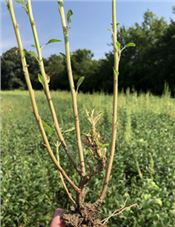
Shortened branch 2nd from right was original apical meristem…. It was 4” tall and never re-grew after Engenia applicaton
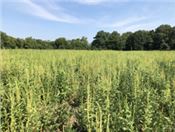
Xtend soybeans wrapped Up with Palmer amaranth that escaped Engenia + Roundup PM + Warrant
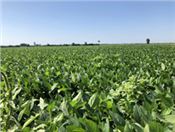
Xtend soybean field where Palmer amaranth escaped Engenia + Roundup PM
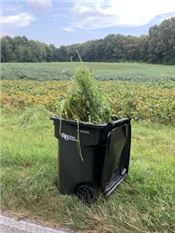
Palmer amaranth pulled out of an Xtend cotton field
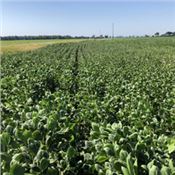
LL soybeans across the road showing dicamba injury